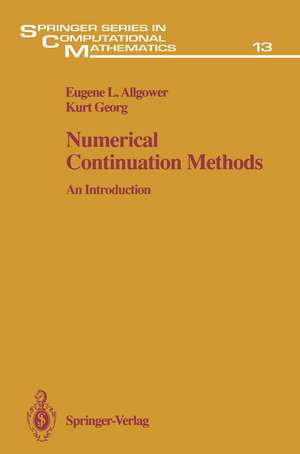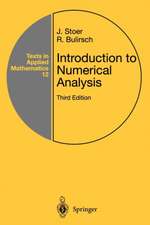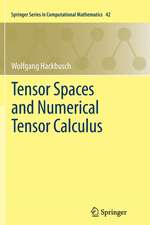Numerical Continuation Methods: An Introduction: Springer Series in Computational Mathematics, cartea 13
Autor Eugene L. Allgower, Kurt Georgen Limba Engleză Paperback – oct 2011
Din seria Springer Series in Computational Mathematics
- 24%
 Preț: 703.01 lei
Preț: 703.01 lei - 15%
 Preț: 497.64 lei
Preț: 497.64 lei - 18%
 Preț: 726.85 lei
Preț: 726.85 lei -
 Preț: 403.91 lei
Preț: 403.91 lei -
 Preț: 386.61 lei
Preț: 386.61 lei - 18%
 Preț: 1399.11 lei
Preț: 1399.11 lei - 18%
 Preț: 1395.94 lei
Preț: 1395.94 lei - 18%
 Preț: 784.48 lei
Preț: 784.48 lei - 20%
 Preț: 996.22 lei
Preț: 996.22 lei - 24%
 Preț: 635.75 lei
Preț: 635.75 lei - 15%
 Preț: 649.22 lei
Preț: 649.22 lei -
 Preț: 400.47 lei
Preț: 400.47 lei - 18%
 Preț: 740.44 lei
Preț: 740.44 lei - 15%
 Preț: 643.65 lei
Preț: 643.65 lei -
 Preț: 380.63 lei
Preț: 380.63 lei - 18%
 Preț: 904.74 lei
Preț: 904.74 lei - 18%
 Preț: 1014.28 lei
Preț: 1014.28 lei - 18%
 Preț: 1111.97 lei
Preț: 1111.97 lei -
 Preț: 393.90 lei
Preț: 393.90 lei - 18%
 Preț: 947.98 lei
Preț: 947.98 lei - 15%
 Preț: 650.04 lei
Preț: 650.04 lei - 15%
 Preț: 658.05 lei
Preț: 658.05 lei - 15%
 Preț: 521.60 lei
Preț: 521.60 lei - 15%
 Preț: 660.04 lei
Preț: 660.04 lei - 18%
 Preț: 1397.52 lei
Preț: 1397.52 lei - 18%
 Preț: 1126.35 lei
Preț: 1126.35 lei - 18%
 Preț: 1117.48 lei
Preț: 1117.48 lei - 18%
 Preț: 793.76 lei
Preț: 793.76 lei - 15%
 Preț: 710.23 lei
Preț: 710.23 lei
Preț: 394.51 lei
Nou
Puncte Express: 592
Preț estimativ în valută:
75.50€ • 78.53$ • 62.33£
75.50€ • 78.53$ • 62.33£
Carte tipărită la comandă
Livrare economică 14-28 aprilie
Preluare comenzi: 021 569.72.76
Specificații
ISBN-13: 9783642647642
ISBN-10: 3642647642
Pagini: 408
Ilustrații: XIV, 388 p.
Dimensiuni: 155 x 235 x 21 mm
Greutate: 0.57 kg
Ediția:Softcover reprint of the original 1st ed. 1990
Editura: Springer Berlin, Heidelberg
Colecția Springer
Seria Springer Series in Computational Mathematics
Locul publicării:Berlin, Heidelberg, Germany
ISBN-10: 3642647642
Pagini: 408
Ilustrații: XIV, 388 p.
Dimensiuni: 155 x 235 x 21 mm
Greutate: 0.57 kg
Ediția:Softcover reprint of the original 1st ed. 1990
Editura: Springer Berlin, Heidelberg
Colecția Springer
Seria Springer Series in Computational Mathematics
Locul publicării:Berlin, Heidelberg, Germany
Public țintă
ResearchCuprins
1 Introduction.- 2 The Basic Principles of Continuation Methods.- 2.1 Implicitly Defined Curves.- 2.2 The Basic Concepts of PC Methods.- 2.3 The Basic Concepts of PL Methods.- 3 Newton’s Method as Corrector.- 3.1 Motivation.- 3.2 The Moore-Penrose Inverse in a Special Case.- 3.3 A Newton’s Step for Underdetermined Nonlinear Systems.- 3.4 Convergence Properties of Newton’s Method.- 4 Solving the Linear Systems.- 4.1 Using a QR Decomposition.- 4.2 Givens Rotations for Obtaining a QR Decomposition.- 4.3 Error Analysis.- 4.4 Scaling of the Dependent Variables.- 4.5 Using LU Decompositions.- 5 Convergence of Euler-Newton-Like Methods.- 5.1 An Approximate Euler-Newton Method.- 5.2 A Convergence Theorem for PC Methods.- 6 Steplength Adaptations for the Predictor.- 6.1 Steplength Adaptation by Asymptotic Expansion.- 6.2 The Steplength Adaptation of Den Heijer & Rheinboldt.- 6.3 Steplength Strategies Involving Variable Order Predictors.- 7 Predictor-Corrector Methods Using Updating.- 7.1 Broyden’s “Good” Update Formula.- 7.2 Broyden Updates Along a Curve.- 8 Detection of Bifurcation Points Along a Curve.- 8.1 Simple Bifurcation Points.- 8.2 Switching Branches Via Perturbation.- 8.3 Branching Off Via the Bifurcation Equation.- 9 Calculating Special Points of the Solution Curve.- 9.1 Introduction.- 9.2 Calculating Zero Points f(c(s)) = 0.- 9.3 Calculating Extremal Points minsf((c(s)).- 10 Large Scale Problems.- 10.1 Introduction.- 10.2 General Large Scale Solvers.- 10.3 Nonlinear Conjugate Gradient Methods as Correctors.- 11 Numerically Implementable Existence Proofs.- 11.1 Preliminary Remarks.- 11.2 An Example of an Implementable Existence Theorem.- 11.3 Several Implementations for Obtaining Brouwer Fixed Points.- 11.4 Global Newton and Global Homotopy Methods.- 11.5Multiple Solutions.- 11.6 Polynomial Systems.- 11.7 Nonlinear Complementarity.- 11.8 Critical Points and Continuation Methods.- 12 PL Continuation Methods.- 12.1 Introduction.- 12.2 PL Approximations.- 12.3 A PL Algorithm for Tracing H(u) = 0.- 12.4 Numerical Implementation of a PL Continuation Algorithm.- 12.5 Integer Labeling.- 12.6 Truncation Errors.- 13 PL Homotopy Algorithms.- 13.1 Set-Valued Maps.- 13.2 Merrill’s Restart Algorithm.- 13.3 Some Triangulations and their Implementations.- 13.4 The Homotopy Algorithm of Eaves & Saigal.- 13.5 Mixing PL and Newton Steps.- 13.6 Automatic Pivots for the Eaves-Saigal Algorithm.- 14 General PL Algorithms on PL Manifolds.- 14.1 PL Manifolds.- 14.2 Orientation and Index.- 14.3 Lemke’s Algorithm for the Linear Complementarity Problem.- 14.4 Variable Dimension Algorithms.- 14.5 Exploiting Special Structure.- 15 Approximating Implicitly Defined Manifolds.- 15.1 Introduction.- 15.2 Newton’s Method and Orthogonal Decompositions Revisited.- 15.3 The Moving Frame Algorithm.- 15.4 Approximating Manifolds by PL Methods.- 15.5 Approximation Estimates.- 16 Update Methods and their Numerical Stability.- 16.1 Introduction.- 16.2 Updates Using the Sherman-Morrison Formula.- 16.3 QR Factorization.- 16.4 LU Factorization.- P1 A Simple PC Continuation Method.- P2 A PL Homotopy Method.- P3 A Simple Euler-Newton Update Method.- P4 A Continuation Algorithm for Handling Bifurcation.- P5 A PL Surface Generator.- P6 SCOUT — Simplicial Continuation Utilities.- P6.1 Introduction.- P6.2 Computational Algorithms.- P6.3 Interactive Techniques.- P6.4 Commands.- P6.5 Example: Periodic Solutions to a Differential Delay Equation.- Index and Notation.














